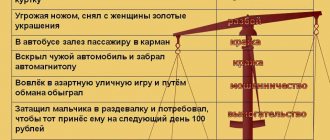Article 162 of the Criminal Code of the Russian Federation speaks of a dangerous criminal act called robbery. This crime in its various forms belongs to the category of grave and especially grave.
Despite the fact that robbery is in the chapter that talks about acts directed against property relations, the theft of property in its composition is by no means the main thing.
The main thing is an attack with the use (or threat) of dangerous violence. What types of robbery has the legislator provided for and what is the penalty for robbery alone or by a group of persons under Article 162 of the Criminal Code of the Russian Federation?
Kinds
By carrying out robbery, a criminal act is committed to forcibly confiscate someone else's property for the purpose of appropriating it.
This process can occur with varying
degrees of cruelty , it is characterized by the manifestation of violence as a result of the illegal seizure of property.
Types of robbery are determined by variety, through a differentiated approach, according to the characteristics of robbery.
Property
Includes the basic characteristics of the crime. The concept of property robbery has the motive of theft, without the use of violence, threats and other aggravating characteristics.
Despite the fact that every robbery implies the possibility of violence under certain circumstances, in such cases it is not used.
As a rule, in this case, criminals look for opportunities without aggravating the nature of the crime.
Attempted robbery
It is defined as part of a crime in the case when a criminal (group) initiated a criminal action that was not carried out for objective reasons.
Minors
In a criminal act committed by a group of persons under the age of 18 , which allows them to have an advantage in determining responsibility and punishment for the act committed, since there are features of criminal punishment in Russia .
For the involvement of minors in a crime of a robbery nature, the organizer of the group will bear additional responsibility, and his criminal status will be determined as qualified .
Often the organizers of organized crime groups involving minors are experienced criminals.
Robbery by an organized crime group is a robbery committed by an organized criminal group.
Armed
A crime with elements of qualification even if no weapon was used. Its presence indicates that the crime was prepared with the degree of acceptance of its use. In such cases, the degree of qualification and possible human casualties depends on the will of chance, which helped to avoid them.
If the robbery with a weapon was carried out using an air pistol, this also aggravates the guilt, due to the fact that the victim, based on the threat with a weapon, will take it seriously.
bodily injuries of varying severity can be taken into account as such .
Robbery: the concept and essence of the offense
Criminal law interprets robbery as an attack on a person, which is carried out using violent actions that are potentially dangerous to the health and life of the victim, or the threat of committing these actions (including the use of weapons). The main goal of a robbery is to take possession of the victim’s material property.
At the same time, the key condition for defining the actions themselves as robbery is that the method of attack is recognized as dangerous to the health and life of the injured party.
If there are only threats of violence, it will be more difficult to qualify robbery - the very nature of the attacker’s statements will be taken into account.
Most Qualified
Often it is carried out with particular cynicism, and even cruelty. As a rule, in such cases, robbery is carried out with the commission of murder .
That is, the method of appropriating someone else's property is associated with the destruction of the life of the owner of the seized property .
Murder associated with robbery should be classified according to the following categories of this type:
- Road robbery;
- Robbery by a group of persons;
- Robbery committed by a group of persons by prior conspiracy;
- Sea robbery.
The composition and types of crimes can be called classical, since they are rooted in the deep historical past of the social consciousness of mankind. Naturally, in the modern world they have acquired a new color.
Group of persons
Robbery committed by a group of persons by prior agreement (and without it) is the basic prerogative of an organized crime group. They carry out the majority of crimes of this type.
The murders of victims during criminal operations are quite numerous. In the concepts of this type of underworld, the value of human life is not included.
On the roads
Applies to theft of transported property of persons. In such situations, truck drivers often lose their lives on the highway. Also, robbery on the roads is associated with the theft of expensive cars and funds available to drivers.
Sea robbery
Piracy has always been punished with the most severe penalties. Persons who encroached on such a way of life were forever outcasts not only in their own country, but also in friendly countries that were ready to capture and surrender criminals of this type. And this is no coincidence, since maritime robbery enters the arena of global crime. He not only causes property damage through direct robbery.
Maritime robbery blocks the functioning of the most important waterways through which the economic interests of various states are communicated.
Unfortunately, such evil is still ineradicable today. Modern maritime robbery goes beyond property, since the concept, composition and its types simultaneously include the kidnapping of people or their illegal detention, murder, and torture.
How is robbery different from robbery, extortion and banditry?
On what grounds will a robbery differ from robbery, extortion, banditry? The key difference between robbery and robbery (Article 161 of the Criminal Code of the Russian Federation) is the violent component - the taking of someone else's property occurs with the deliberate use of techniques dangerous to the health and life of the victim.
At the same time, the use of weapons, one of the signs of robbery, as a rule, does not appear in a robbery.
Unlike extortion (Article 187 of the Criminal Code of the Russian Federation), where violent physical techniques are a form of psychological violence as a threat of use in case of disobedience to the demands of the extortionist, robbery involves the use of violence to seize the victim’s property.
The actions of armed robbers and banditry (Article 209 of the Criminal Code of the Russian Federation) are distinguished by the fact that the latter is characterized by the stability of the composition and structure of the criminal group, stability in the methods and forms of carrying out their bandit activities. Unlike robbers, members of the group may have not only bladed weapons or firearms, but also pneumatic weapons and explosive devices.
Qualifying features
A common feature of robbery and extortion is the appropriation of someone else's property , under the threat of violence or with the use of such.
Unlike other crimes of a property nature, robbery, the use of violence is the most dangerous of all crimes in this category.
Sign of robbery Art. 162 of the Criminal Code of the Russian Federation cannot serve violence that is not based on selfish motives and the goals of taking possession of the property of the victim (group of victims).
The corpus delicti is qualified when it is carried out:
- With the use of weapons or the threat of using weapons;
- By a group of persons by prior agreement (or without it);
- When attracting minors;
- A criminal act that led to the death of the victim ( Qualified murder in the commission of robbery ).
Robbery (Article 162 of the Criminal Code)
Robbery is the most dangerous form of theft. It is defined as an attack for the purpose of stealing someone else's property, committed with the use of violence dangerous to life or health, or with the threat of such violence. The danger of robbery is determined not so much by the encroachment on property relations itself, but by the method of such encroachment - an attack combined with the actual use of violence dangerous to the life or health of the person attacked, or with the threat of such violence. The increased danger of the crime in question is determined by its two-objective nature.
The objects of robbery are property relations, human life and health, and public order.
The immediate targets of robbery: firstly, the specific form of ownership, and secondly, the health of the person attacked. The statement found in the literature that the additional direct object of robbery is human life and health is erroneous. Life is not the object of this crime, therefore the actual causing of death goes beyond the scope of robbery and requires additional qualifications.
The objective side of robbery (Part 1 of Article 162)
consists of an attack with the aim of stealing someone else's property. An attack is an active action by the perpetrator that is unexpected for the victim, involving the use or threat of use of violence dangerous to life and health. Thus, the distinctive feature of an attack as a method of committing robbery is the use or threat of use of violence.
A mandatory objective sign of robbery is the use or threat of use of violence dangerous to life or health. To qualify a crime as robbery, it is enough that the violence creates a danger at least to health.
Violence should be considered life-threatening if the method of its use created a real danger of death, even if it did not cause any real harm to health (for example, suffocation, prolonged holding of the victim’s head under water, etc.).
Violence used during robbery is dangerous to life and health. Since causing grievous harm to health refers to especially qualified types of robbery (clause “c” of Part 3 of Article 162), the objective side of Parts 1 and 2 of this article is violence that resulted in light or moderate harm to health.
Violence associated with squeezing the respiratory tract, being thrown from a height, or exposing the victim to potent nerve agents or toxic substances is life-threatening at the time of infliction. The use of such violence is classified as robbery, even if the result does not cause any harm to the health of the victim.
The Plenum of the Supreme Court of the Russian Federation indicated that violence dangerous to life or health (Article 162 of the Criminal Code) should be understood as violence that resulted in the infliction of grave and moderate harm to the health of the victim, as well as the infliction of minor harm to health, causing a short-term health disorder or minor permanent loss of general ability to work (clause 21 of the Resolution of the Plenum of the Supreme Court of the Russian Federation of December 27, 2002 No. 29 “On judicial practice in cases of theft, robbery and robbery”). According to Part 1 of Art. 162 of the Criminal Code should qualify an attack for the purpose of taking property, committed with the use of violence dangerous to life or health, which, although it did not cause harm to the health of the victim, however, at the time of use created a real danger to his life or health.
The threat of violence (mental violence) consists of intimidating the victim with the immediate use of physical violence against him, dangerous to life and health. The threat can be addressed not only directly to the victim, but also to persons close to him who are present at the crime scene. The threat must be perceived by the victim as valid and real. For the disposition of Part 1 of Art. 162 threat may consist of appropriate words and gestures. It is not excluded that a threat to kill may be made, with additional qualifications under Art. 119 is not required. The threat during robbery acts as a means of stealing property, which the perpetrator resorts to as an alternative to the use of violence.
Violence or the threat of its use during robbery serves as a means of seizing someone else's property. A crime can be started as theft or robbery, but in cases where the perpetrator used or threatened to use violence dangerous to life and health (for example, the victim noticed that they were trying to steal his property, decided to stop the actions of the perpetrator, and he took possession of his property, causing victim of injuries of varying severity), his actions are qualified under Art. 162 of the Criminal Code. If the culprit, caught in the act of a crime, uses violence against the victim in order to escape prosecution, then his actions are qualified as theft and a corresponding crime against the person.
On its objective side, robbery is a specific form of theft that does not fall under its general definition. If any other form of theft is characterized as the unlawful and gratuitous seizure of someone else's property, then robbery is defined in the law not as the seizure of someone else's property, but as an attack for the purpose of stealing someone else's property. Robbery is the so-called “truncated
» composition: the crime is considered completed from the moment the attack begins, committed with the use of violence dangerous to life or health, or with the threat of such violence, regardless of whether the actual confiscation of property followed or whether real harm was caused to the health of the victim.
Robbery is closely related to robbery committed with the use or threat of violence (clause “d”, part 2 of article 161). The difference between them lies in the nature of the violence applied to the victim. Robbery involves the use of violence that is dangerous to life or health, and violent robbery is an impact on the victim that is not dangerous to life or health. In addition, the moment of completion of these crimes should be taken into account (the material elements of robbery presuppose the taking of someone else’s property, while the elements of robbery do not). When distinguishing between robbery and robbery, the method of action of the perpetrator is also important (the use of weapons or objects used as weapons should always be classified as robbery, regardless of the nature of the consequences).
In cases where the seizure of property is associated with a threat of violence that is of an uncertain nature, the question of recognizing the person’s actions as robbery or robbery must be decided taking into account all the circumstances of the case: the place and time of the crime, the number of attackers, the nature of the objects with which they threatened the victim , subjective perception of a threat, the commission of any specific demonstrative actions indicating the intention of the attackers to use physical violence, etc. If, during the theft of someone else’s property, a violent restriction of freedom is applied to the victim, then the question of recognizing the person’s actions as robbery or robbery should be decided taking into account the nature and degree of danger of these actions to life or health, as well as the consequences that occurred or could occur (for example, leaving a tied victim in a cold room, depriving him of the opportunity to seek help).
The subjective side of robbery is characterized by direct intent. In the disposition of Part 1 of Art. 162 defines the purpose of the crime – taking possession of someone else’s property. If the term “seizure” implies the removal of property from the possession of the victim against his will, then the term “taking” contains a reference to the violent nature of criminal actions.
If violence is not used for the purpose of seizing property, then these actions may, depending on the circumstances of the case, be classified as crimes against the person, hooliganism, arbitrariness, etc.
The subject of the crime is a person who has reached the age of 14.
It is noteworthy that the qualified composition of robbery, like robbery, does not contain such a sign as causing significant damage to a citizen, since the degree of public danger of robbery is so great that the size
damage caused to a citizen does not have a qualifying significance, unless, of course, it is major.
Qualifying features
robbery basically coincides with the corresponding signs of theft, fraud and robbery.
Two signs are characteristic exclusively of robbery: the commission of robbery with the use of weapons or objects used as weapons (part 2 of article 162)
, and the commission of robbery with the infliction of grievous harm to the health of the victim
(clause “c” of part 4 of article 162 )
.
The use of weapons during robbery can be expressed in the form of its demonstration to the victim and in the form of direct use, which creates the possibility of causing serious harm to the health or death of the victim.
During robbery, firearms, bladed weapons or gas weapons, explosives or explosive devices may be used.
Objects used as weapons should be understood as objects that could cause bodily harm to the victim that are dangerous to life or health (penknife or kitchen knife, razor, crowbar, baton, axe, flare gun, etc.), as well as objects , intended for temporary destruction of a target (for example, mechanical sprayers, aerosol and other devices equipped with tear and irritant substances). Objects used as weapons also include objects specially made or adapted to inflict bodily harm, as well as any objects actually used by the perpetrator in the attack (an axe, a stone, a hammer, a screwdriver, etc.), even if they were taken at the crime scene.
The use of weapons can be expressed in physical or mental impact on the victim. Mental impact is expressed in threatening the victim with this weapon (shooting in the air or at the ground, putting it to the victim’s body, etc.).
If a person only demonstrated a weapon or threatened with a obviously unusable or unloaded weapon or an imitation weapon, for example, a dummy pistol, a toy dagger, etc., without intending to use these objects to cause bodily harm dangerous to life or health, then his actions (in the absence of other aggravating circumstances), taking into account the specific circumstances of the case, should be qualified as robbery, liability for which is provided for in Part 1 of Art. 162 of the Criminal Code of the Russian Federation, or as robbery, if the victim understood that he was being threatened with an unusable or unloaded weapon or an imitation weapon.
In cases where, for the purpose of stealing someone else's property, a potent, poisonous or intoxicating substance dangerous to life or health is introduced into the victim's body against his will or by deception in order to bring the victim into a helpless state, the act must be qualified as robbery. If, for the same purpose, a substance that does not pose a threat to life or health is introduced into the victim’s body, the act must be classified, depending on the consequences, as robbery combined with violence. The properties and nature of the action of substances used in the commission of these crimes can, if necessary, be established with the help of an appropriate specialist or by expert means.
Robbery committed with infliction of grievous harm to the health of the victim (clause “c”, part 4 of article 162)
, presupposes the occurrence of one of the consequences specified in Art. 111 of the Criminal Code. Causing grievous bodily harm during robbery is covered by this crime and additional qualifications under Art. 111 is not required. Minor harm to health and harm to health of moderate severity are covered by Part 1 of Art. 162.
If a person commits murder of the victim during a robbery, then what he has done should be qualified under paragraph “h” of Part 2 of Art. 105 of the Criminal Code, as well as under paragraph “c” of Part 4 of Art. 162 of the Criminal Code. If there are other aggravating circumstances in the actions of the person guilty of robbery (for example, robbery committed by a group of persons by prior conspiracy, with illegal entry into a home, with the use of weapons, etc.), these signs of the objective side of robbery must be indicated in the descriptive part of the sentence .
Theft, which began as theft or robbery, may develop into robbery in the process of implementation if the perpetrator, in order to take possession of property or retain it after taking it, uses violence dangerous to life or health, or threatens to use such violence. But if violence, dangerous to life or health, is used after the end of the theft or robbery and does not pursue the goal of retaining property, but is used, for example, to avoid arrest, it cannot indicate robbery and must be qualified under the articles of the Criminal Code on crimes against the person or against management order.
Qualification Features
Robbery is not classified in relation to property damage caused.
Other crimes of a property nature have the following qualification :
- General damage;
- State;
- To a private person;
- Legal entity.
This point is due to the fact that in relation to countering this type of crime, the priority is the principle of the structural organization of the criminal community. At the same time, the most important element is the value of human life , which is endangered in the process of carrying out robberies.
Simple unskilled
Part 1 of Article 162 describes ordinary robbery without additional aggravating circumstances. Its essence is an attack using violence that is dangerous to life or health (or with the threat of such violence). The purpose of this crime is the theft of someone else's property.
In this case, the criminal acts alone; he does not use weapons or objects that replace them. Property damage as such is not relevant. The theft may not take place at all for one reason or another (for example, the person did not have valuable property on him that the criminal was counting on, or the attacker received a rebuff from the victim himself or third parties). The main thing is that the attack was committed for the purpose of theft, which means that this crime complies with Part 1 of Article 162.
Important. What is an attack? This is an impact on the individual, aggressive and violent. It is possible in both open and hidden forms (for example, a sudden blow from behind).
Situations when an intoxicating, narcotic, toxic substance or drug is introduced into the human body, which leads the person into a helpless state (the person may not even realize that he is being affected by such a drug), are also considered an attack.
However, if a person voluntarily, without coercion, took such a substance, drug (alcohol, drug, etc.), then this is no longer regarded as an attack. A criminal can attack both the owner of the property and a third party (to whom, for example, this property is entrusted, or he is trying to resist the attacker during the attack, etc.).
Dangerous violent acts come in many forms. These are strong blows (for example, with the hands or feet of a criminal), squeezing the victim’s neck in order to intimidate, placing the victim’s head under water (also in order to break resistance and force him to comply with the demands of the raiders) and much more.
Life-threatening violence is actions that pose a real threat to life (even if such consequences do not occur).
Violence dangerous to health is violence that caused slight or moderate harm to a person’s health (even if the consequences did not occur, but at the time of the use of violence there was a risk of such consequences occurring). Violence can also be psychological (threats of murder, grievous bodily harm, etc.).
An example of a robbery from Part 1 of Article 162 could be an attack on a citizen on the street. The criminal inflicts several blows on the victim, strangles him, threatens to kill him and forces him to hand over items of precious metals and money.
Corpus delicti
- The subject is a person who has reached the age of 14 years and is of sound mind.
- The subjective side of robbery is represented by direct intent, the motive of self-interest and a specific goal: to steal someone else's property.
- The immediate objects that are being attacked are the specific form of property + the health of the person being attacked by the criminal.
- The objective side is an attack on a person or organization using violence that poses a danger to life and health (as well as the threat of this violence).
Responsibility
For a criminal who has committed a robbery, qualified under Part 1 of Article 162, the law provides for the following penalties:
- isolation from society in places of deprivation of liberty (MPL) for a period of up to 8 years with a fine of up to 500 thousand rubles or in the amount of the income of the perpetrator for a period of up to 3 years or without this fine;
- or forced labor for up to 5 years.
31. Robbery. Difference from robbery.
Object of crime: main
— relations of a certain form of ownership;
elective
- personal health.
Item
- someone else's property.
Objective side
consists of open theft of someone else's property.
An open method of theft means that
the perpetrator seizes someone else's property, realizing that his actions and their criminal nature are obvious to the owner, another owner or other persons, but ignores this circumstance and commits an assault.








